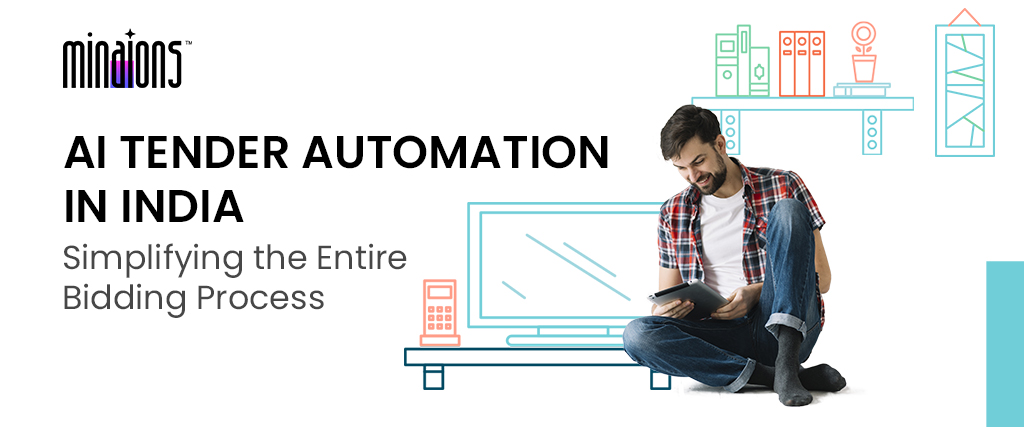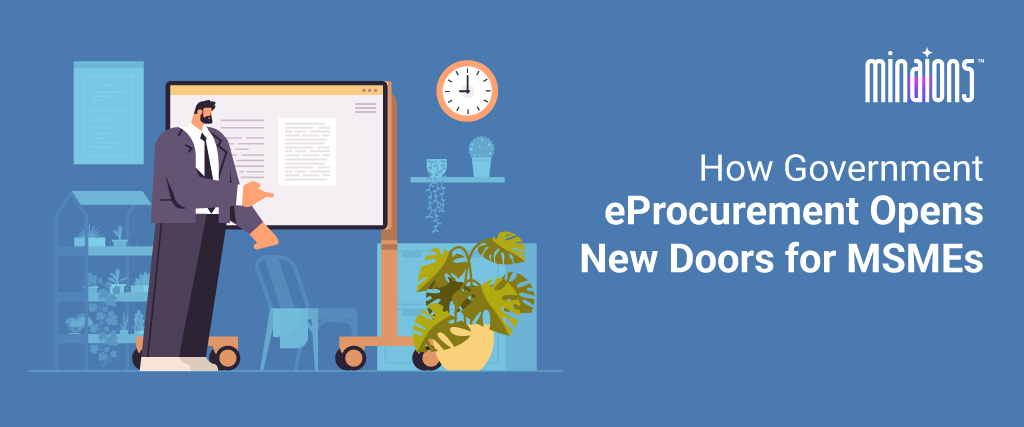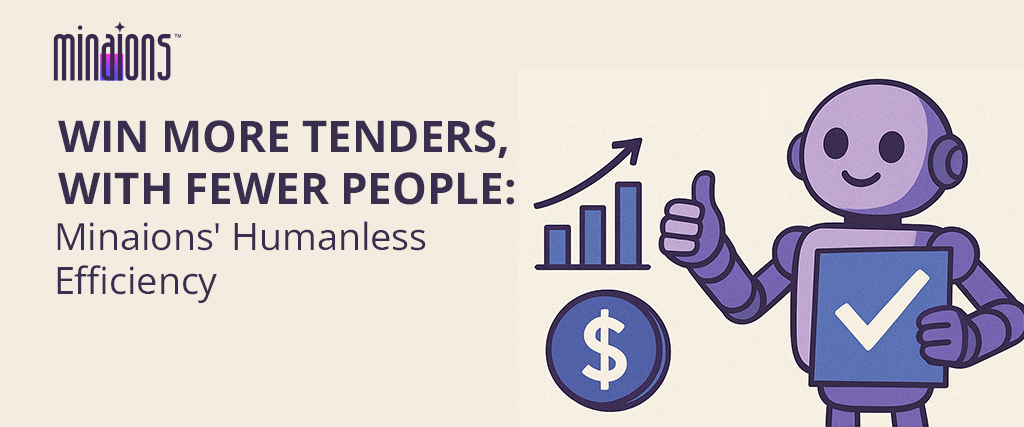AI Tender Automation in India – Simplifying the Entire Bidding Process

In India, government tenders play a large role in shaping business opportunities. For Micro, Small, and Medium Enterprises (MSMEs), these tenders often represent a lifeline, a gateway to steady projects, consistent income, and recognition in the public sector. Yet, the tendering process has never been simple. Long paperwork, repetitive documentation, and complex compliance steps often consume precious hours. Many businesses lose potential contracts not due to lack of capability but because of errors in documentation, missed deadlines, or lack of access to timely information.
With the rise of Artificial Intelligence (AI), this reality is changing fast. Tender automation is no longer a futuristic concept. It’s already helping Indian MSMEs, consultants, and procurement officers handle bids smarter, faster, and with more precision.
AI is now transforming tender management from a manual, time-heavy activity into a data-driven, automated process.
This article explores how AI tender automation is simplifying the entire bidding cycle, from identifying relevant tenders to preparing compliant proposals, while saving time and reducing the margin of error.
The Traditional Tendering Challenge
Before AI tools entered the picture, the tendering process was heavily manual.
Businesses had to:
Search for new tenders across multiple government portals.
Download and read lengthy documents filled with legal and technical jargon.
Check eligibility and compliance criteria line by line.
Prepare bid documents, often using templates copied from older submissions.
Track submission dates and modifications manually.
For small teams or individual consultants, this meant days of effort, sometimes just to discover that a tender was not even relevant to them. The complexity discouraged many capable MSMEs from competing, giving larger companies an unfair advantage. Even when tenders were submitted, missing a small document, a stamp, or a clause could disqualify a bid instantly. Government procurement officers, too, faced challenges. Evaluating hundreds of documents manually increased the risk of human oversight, duplication, and delays in awarding contracts.
The Shift Towards Digital Procurement
Over the last decade, India has made steady progress towards digital procurement. Platforms like Government e-Marketplace (GeM) and the Central Public Procurement Portal (CPPP) have digitised the tender publishing and submission process. These systems allow bidders to upload documents online, track status, and receive alerts. However, while the platforms became digital, the process itself remained heavily dependent on human effort. Bid preparation still required careful reading, interpretation, and documentation, tasks prone to fatigue and error. This is the gap AI is now filling.
AI: The Next Step in Procurement Evolution
AI tender automation goes beyond digitisation. It introduces intelligence into every stage of the process. Instead of just hosting tender documents online, AI reads, interprets, and categorises them automatically. It can identify eligibility criteria, extract relevant clauses. For instance, a business using AI tools can receive instant notifications of tenders that match its profile. It no longer needs to spend hours searching across multiple portals. AI also analyses previous bid outcomes to suggest the most suitable opportunities. In essence, AI automation transforms tendering from a manual chore into a strategic, data-backed process.
The Tender Ecosystem in India: An Overview
India’s tendering ecosystem involves a variety of government departments, public sector undertakings (PSUs), and municipal bodies. Each uses different procurement platforms, follows distinct document structures, and applies its own evaluation norms. This fragmentation makes it difficult for businesses to track and participate efficiently. A company specialising in civil construction might need to check both central and state-level portals, each with unique documentation styles. AI tender automation platforms like Minaions are bridging this gap. By integrating multiple tender sources into one interface, these platforms give users a unified view of all relevant opportunities. They also use Natural Language Processing (NLP) to understand the intent behind tender documents, making classification and filtering far more accurate.
Why AI Tender Automation Matters Today
The timing for AI in procurement could not be better. India’s public procurement market is estimated to be worth over ₹5 lakh crore annually, offering vast opportunities for businesses of all sizes. However, participation levels among MSMEs remain relatively low, partly due to the inefficiencies and complexities in manual tendering. AI-driven automation tools help bridge this gap by:
Reducing human dependency in repetitive tasks.
Improving accuracy in document reading and interpretation.
Saving time in bid preparation and submission.
Helping procurement officers evaluate bids more efficiently.
As digital governance gains momentum, tender automation will soon become a standard, not a luxury.
From Manual Bidding to AI-Driven Strategy
Traditionally, bidding relied on intuition and experience. Bid managers reviewed tender documents, selected opportunities that felt right, and wrote proposals based on past templates. While this approach worked in the past, today’s data-heavy environment demands precision.
AI allows bidders to make decisions based on insights rather than assumptions. It identifies high-probability tenders by analysing parameters like budget, region, competition history, and eligibility match. This shift from manual to intelligent bidding is changing how MSMEs approach government contracts. Instead of chasing every opportunity, they now focus on those with the highest win potential.
1. Tender Discovery and Matching
The first challenge for most MSMEs is finding relevant tenders. Government departments and PSUs publish thousands every week across multiple platforms , GeM, CPPP, eProcurement portals of states, and departmental websites. Manually tracking each of them is nearly impossible. AI simplifies this with automated discovery. It scans hundreds of government portals daily, extracting tender notices and categorising them based on industry, geography, budget, and keywords. For instance, if you’re a supplier of electrical equipment serving pan India, the Minaions AI system will identify tenders related to "electrical installation," "power cables," or "transformer maintenance" for you Pan India.
No more browsing dozens of portals or reading irrelevant listings. This intelligent filtering is powered by Natural Language Processing (NLP). Unlike basic keyword searches, NLP understands the meaning behind words. So even if a tender says “supply of lighting fixtures” instead of “electrical goods,” the AI still recognises its relevance. With platforms like Minaions, users can save their preferences. The system automatically sends alerts when new tenders match their profile. This allows MSMEs to react faster than competitors, increasing their chances of early participation.
2. Tender Document Analysis
Tender documents can be long, dense, and filled with legal and technical jargon.
Reading and interpreting them manually can take hours.
Errors or missed clauses can lead to disqualification.
AI tender automation tools use document parsing to extract key information automatically.
This includes:
Eligibility requirements
Bid submission deadlines
Payment and EMD details
Technical specifications
Evaluation criteria
By breaking down each section into structured data, AI gives users a quick, clear summary of what the tender demands. This analysis is not just faster, it’s more accurate. The system never gets tired or overlooks small details. It highlights missing documents or sections that require special attention, saving businesses from costly mistakes. For procurement officers, this feature helps during evaluation as well. AI-based extraction simplifies the process of comparing bids and verifying compliance.
3. Eligibility and Compliance Checking
Every tender has unique eligibility conditions, previous experience, financial turnover, certifications, or specific licences. Meeting these requirements determines qualification. AI tools cross-check the bidder’s stored data (like certificates, GST details, or turnover records) against tender conditions. If any requirement is missing, the system alerts the user immediately. For example, if a tender demands ISO 9001 certification and the company lacks it, the AI flags it early. This prevents wasted effort in preparing bids for tenders that cannot be qualified. It also recommends suitable tenders that fit the company’s profile based on existing credentials. This kind of smart matching saves time and resources, especially for small teams or freelance bid managers handling multiple clients.
4. Automated Bid Preparation
This is one of the most powerful features of AI tender automation. Once relevant tenders are shortlisted, the next challenge is preparing documents, filling forms, and writing technical or financial bids. AI-driven platforms assist by:
Generating bid templates based on previous submissions.
Auto-filling repetitive company data.
Drafting cover letters, declarations, and checklists.
Suggesting phrases and formats used in winning bids.
Some tools also apply predictive analysis, studying historical data to suggest pricing strategies or highlight tenders with higher win probability. For instance, Minaions’ AI engine can learn from a company’s past bids, identifying what worked and what didn’t, to guide the next submission. This converts past experience into actionable intelligence. Bid preparation, which earlier took several days, can now be completed within hours.
5. Automated Submission
Submitting tenders involves following precise formats, digital signatures, and online uploads. AI simplifies this step through guided submission. It checks for missing files, validates formats, and tracks submission deadlines.
6. Real-World Use Case: MSMEs and Consultants
Let’s consider a mid-sized infrastructure MSME based in Panchkula. Before using AI automation, the team spent about 25 hours each week searching tenders, preparing documents, and tracking updates manually. Errors were frequent, and missed deadlines were common. After adopting the AI tender automation platform, the same team:
Received curated tender alerts every morning.
Used auto-generated bid templates to prepare faster.
Monitored every submission from a single dashboard.
Improved bid participation by nearly 60%.
Consultants managing multiple clients have seen similar benefits. They can now handle five or six clients efficiently instead of two or three, thanks to AI-led automation. Procurement officers report faster evaluation cycles, as the system helps them compare technical and financial bids side by side. The result is not just speed, but fairness and transparency across the ecosystem.
7. How Minaions Fits In
Minaions stands out among AI tender automation tools for its India-focused design. It is built to understand local tender formats, regional language variations, and procurement structures unique to the country.
It offers:
AI-based tender discovery from multiple government sources.
Automated document parsing for quick eligibility analysis.
Smart bid preparation with custom templates.
Integrated compliance checks and workflow management.
For MSMEs, this means a competitive advantage in securing government projects. For procurement officials, it means cleaner submissions and smoother evaluations.
1. The Road Ahead for AI in Procurement
Artificial Intelligence is still evolving, yet its impact on public procurement in India is already visible. From smart document reading to automated bid evaluation, every part of the tendering process is being reshaped. In the coming years, we can expect AI to become a permanent part of both private and government procurement systems. The Indian government has been actively promoting digital transformation through programmes like Digital India and Make in India. These initiatives encourage MSMEs to adopt new technologies and participate more actively in public tenders. AI tender automation aligns perfectly with this vision, providing the technological base for transparent and efficient procurement. In the future, integration between platforms like GeM, CPPP, and AI-driven tender tools will likely deepen. Instead of functioning as separate systems, they may operate as connected digital layers sharing data securely through APIs. This will create a unified, intelligent procurement ecosystem.
2. Evolving Role of MSMEs
Micro, Small, and Medium Enterprises are the backbone of India’s industrial economy. Yet, many still face challenges in navigating government procurement due to limited manpower or a lack of tendering experience. AI is leveling this playing field. It empowers small businesses with the same analytical and operational capabilities that large corporations enjoy. By automating repetitive tasks, MSMEs can focus on crafting better proposals and strengthening delivery capabilities. For example, an MSME can now participate in 50 or more tenders per month with AI support, something that would have been impossible through manual effort. This broader participation increases competition and drives innovation in public projects. As more small businesses use AI tender tools, government departments will also benefit from a richer vendor base and more competitive bids.
3. Government Adoption and Policy Support
The government’s interest in AI for procurement is growing. Several ministries are experimenting with AI-based evaluation and document verification systems to reduce human bias and improve efficiency. Policies promoting Open Data and Interoperable Standards will further help AI systems access tender information more easily. Future procurement portals may adopt built-in AI assistants to guide users through the bidding process. This will lower the learning curve for newcomers and increase transparency. There is also a clear push towards encouraging MSMEs to participate in tenders by simplifying registration and compliance. AI can support these efforts by providing automated eligibility verification and predictive bid success analysis.
4. Data Privacy and Ethical Considerations
As AI takes on more roles in the procurement process, questions of data privacy and ethics arise. Tender documents often contain sensitive information, pricing, project details, and personal identifiers. Protecting this data is a top priority. Modern AI platforms follow strict data encryption and user access controls. For instance, systems like Minaions keep sensitive files within secure servers and never share data without explicit permission. Access logs, audit trails, and role-based permissions ensure that only authorised individuals can view or modify submissions. Another ethical concern is algorithmic bias, the risk of AI systems favouring certain types of bidders. Transparent algorithms and continuous training using diverse data sets are key to maintaining fairness. As regulations evolve, ethical AI standards for public procurement are expected to become part of official policy frameworks.
5. Skill Development and Human-AI Collaboration
Automation does not replace people, it strengthens them. AI tender platforms still depend on human judgment for strategic decisions. Machines can read and analyse, but humans interpret context, build relationships, and negotiate. Therefore, the focus should shift from replacing manpower to reskilling existing professionals. Procurement officers, consultants, and bid managers must learn how to work alongside AI, using its insights to make better decisions. The demand for AI-literate procurement professionals is expected to rise sharply in the coming years. Training programmes that teach both the technical and strategic aspects of AI-based tendering can prepare the workforce for this transition. This will make Indian procurement more agile, data-driven, and globally competitive.
6. How AI Improves Transparency and Accountability
Corruption and opacity have long been challenges in tendering. AI offers a clear solution by automating processes that were once manual and opaque. Machine-driven evaluations leave an auditable trail, making it easier to detect irregularities. AI can also identify patterns that may indicate unethical practices, such as repetitive wins by the same bidder or suspicious bid amounts. Procurement authorities can use this information to maintain fair competition. For bidders, this brings a renewed sense of trust in the system. Moreover, every decision taken by an AI-based platform can be traced back to data, not personal preference. This shift from human subjectivity to data-backed objectivity promotes credibility at every level of public procurement.
7. The Role of Platforms Like Minaions
Minaions is part of this transformation. It is not just a digital tool but a strategic assistant built for India’s unique tendering environment. It understands regional diversity, procurement formats, and industry-specific language. Its AI algorithms are fine-tuned for Indian government tender data, which gives it a distinct edge over generic international tools.
Minaions helps:
MSMEs find relevant tenders faster.
Consultants manage multiple clients effortlessly.
Procurement officers access structured, error-free submissions.
Its dashboard gives complete visibility of every tender in one place, from discovery to ‘Ready to Bid’ Documents. This level of control and clarity helps businesses focus on execution rather than paperwork. By combining AI with practical usability, Minaions represents what the future of Indian procurement could look like, intelligent, transparent, and efficient.
8. The Economic and Environmental Impact
AI tender automation also contributes to sustainability. Digital submissions reduce paper usage and physical storage. Cloud-based document management cuts down on printing and courier costs. As more departments adopt AI tools, the carbon footprint of the tendering process will reduce significantly.
Economically, faster tender cycles mean quicker project execution. This creates jobs and supports regional economic growth. When MSMEs can participate easily, local manufacturing and services also gain momentum, aligning with India’s Atmanirbhar Bharat initiative.
9. Challenges to Overcome
Despite the promise, challenges remain. Internet access and digital literacy still vary across regions. Some MSMEs lack the confidence to trust automation for complex processes. Initial costs, though decreasing, can be a barrier for smaller firms.
To address these issues, awareness campaigns and subsidised access to AI platforms can help. Collaborations between government departments and technology providers may also accelerate adoption. Once early success stories spread, adoption will grow naturally through word-of-mouth and peer networks.
10. The Future: AI as the Standard for Procurement
The next decade will likely witness a complete transformation of India’s tendering landscape. AI will not just assist; it will become part of the standard procurement framework. Predictive bidding, voice-based query assistants, and blockchain-backed verification may soon become routine features. The future is closer than we think, and Minaions is already leading the way.
Conclusion
Tendering in India has always been complex, but AI is making it simpler, smarter, and more inclusive. From small enterprises to large consultancies, everyone now has access to the same powerful tools. The result is a fairer, more efficient procurement ecosystem where time is saved, effort is reduced, and decisions are data-driven. AI tender automation is not merely about convenience; it represents a complete shift in how businesses interact with government opportunities.
For MSMEs, it means broader access and better chances to compete. For procurement officers, it means accuracy, transparency, and speed. Minaions stands at the centre of this shift, turning tendering from a manual burden into a streamlined, intelligent process. The future of bidding in India is not only digital but also intelligent, and it has already begun.



